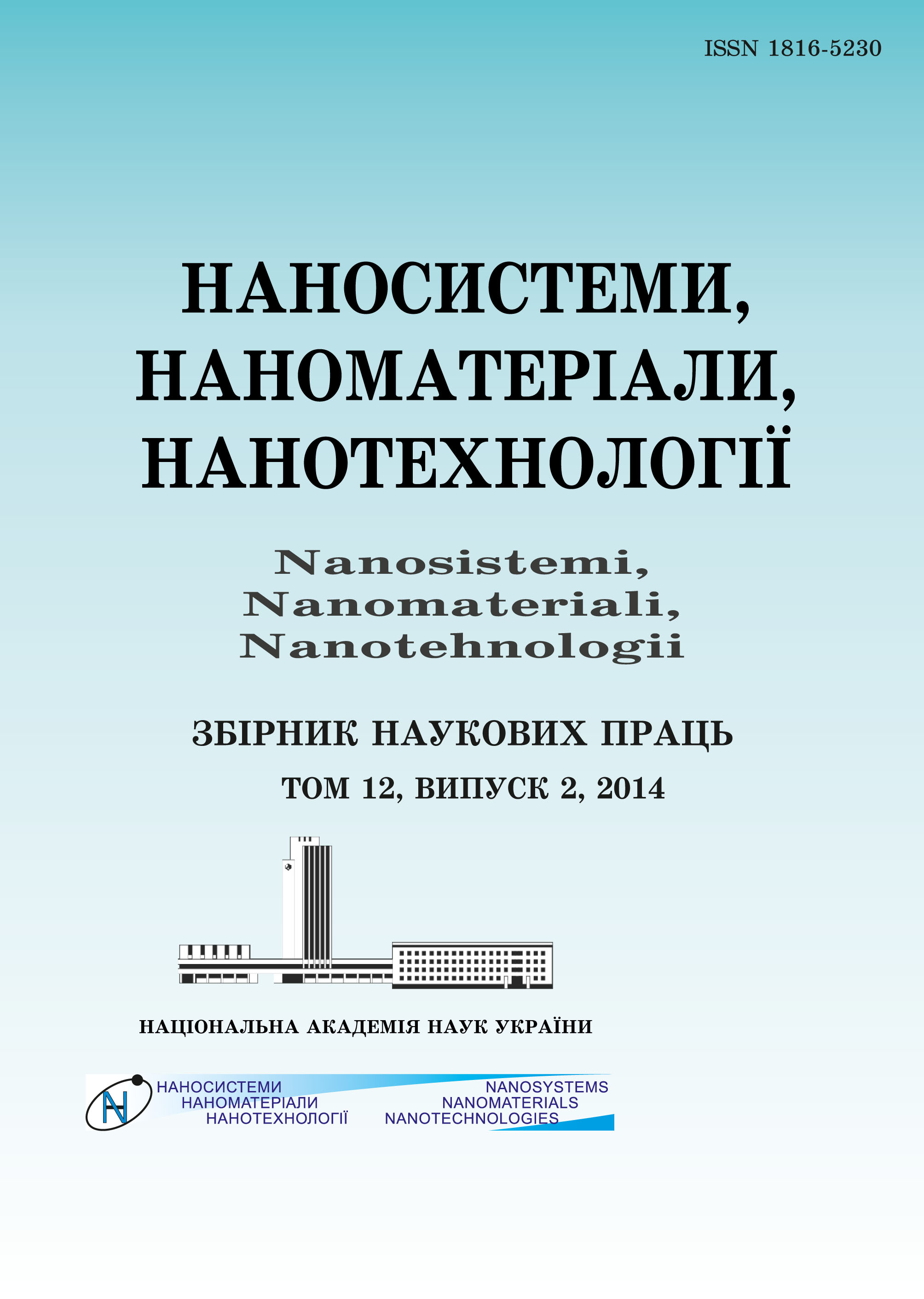|
|
|||||||||

|
Year 2024 Volume 22, Issue 4 |
|
|||||||
|
|||||||||
Issues/2024/vol. 22 /issue 4 |
|
L.O. VORONTSOVA, N.V. BABKINA, O.I. ANTONENKO, L.F. KOSYANCHUK, and
O.O. BROVKO
Effect of Nano-SiO2 Content on Optical
Properties, Damping, and Thermal Stability of Polyurethane Composites
915–928 (2024)
PACS numbers: 62.23.Pq, 62.25.De, 78.67.Sc, 81.07.Pr, 81.16.Be, 81.70.Pg, 82.35.Np
Polyurethane (PU) matrices based on polyester and aromatic diisocyanate with a content of 1, 3, 5, 7 wt.% nano-SiO2 were formed by the in situ method and investigated to determine the optimal composition of PU nanocomposite with a balanced combination of such functional characteristics as transparency, UV protection, damping, and thermal stability. The spectrophotometry method showed that the initial PU matrix and formed PU nanocomposites demonstrate a high (??90%) transmittance in the range of visible wavelengths. At the same time, the PU matrix is characterized by effective blocking of UV radiation with a wavelength of up to ??290 nm, but a bathochromic shift (up to ??315 nm) of the transmission spectra is observed for filled PUs. According to thermogravimetric analysis, the thermal stability of PU composites increases, when nanosize SiO2 is introduced into the matrix. The operating temperature range for this composite is increased by almost 30?Ñ, when the filler content is of 5–7 wt.%. The high damping efficiency of the investigated PUs is shown by the method of dynamic mechanical analysis. PU composite with a content of 7 wt.% nano-SiO2 has a 1.5-fold increase in storage modulus and effective damping temperature range from ?6?Ñ to 47?Ñ. As concluded, the optimal content of nano-SiO2 is of 7 wt.% to provide a balanced combination of such properties as transparency, UV protection, thermal stability, elasticity, and effective damping for PU composite
KEY WORDS: polyurethane, nanocomposite, transparency, ultraviolet protection, damping, thermal stability
DOI: https://doi.org/10.15407/nnn.22.04.915
REFERENCES
- Polymer-Based Multifunctional Nanocomposites and Their Applications (Eds. K. Song, J. Z. Guo, and C. Liu) (Amsterdam: Elsevier: 2019).
- P. Sikdar, T. M. Dip, A. K. Dhar, M. Bhattacharjee, M. S. Hoque, and S. B. Ali, J. Appl. Polym. Sci., 139, No. 38: e52832 (2022); https://doi.org/10.1002/app.52832
- H.-W. Engels, H.-G. Pirkl, R. Albers, R. W. Albach, J. Krause, A. Hoffmann, H. Casselmann, and J. Dormish, Angew. Chem. Int. Ed., 52, No. 36: 9422 (2013); https://doi.org/10.1002/anie.201302766
- Polyurethane Chemistry: Renewable Polyols and Isocyanates. ACS Symposium Series, American Chemical Society (Eds. Ram K. Gupta and Pawan K. Kahol) (Washington, DC: 2021), vol. 1380.
- M. F. Sonnenchein, Polyurethanes: Science, Technology, Markets, and Trends (Hoboken: John Wiley & Sons: 2015).
- I. V. Khudyakov, R. D. Zopf, and N. J. Turro, Designed Monomers and Polymers, 12, No. 4: 279 (2009); https://doi.org/10.1163/156855509X448253
- Polyurethane Polymers: Composites and Nanocomposites (Eds. S. Thomas, J. Datta, J. T. Haponiuk, and A. Reghunadhan) (Amsterdam: Elsevier: 2017).
- S. Chaitoglou, L. Spachis, G. Zisis, I. Raptis, N. Papanikolaou, A. Vavouliotis, R. Penedo, N. Fernandes, and A. Dimoulas, Progress in Organic Coatings, 150: Article 105984 (2021); https://doi.org/10.1016/j.porgcoat.2020.105984
- L. Stroea, A.-L. Chibac-Scutaru, and V. Melinte, Polymers, 13, No. 8: 1318 (2021); https://doi.org/10.3390/polym13081318
- R. Huang, X. Du, H. Wang, X. Cheng, and Z. Du, Journal of Applied Polymer Science, 139, No. 15: 51927 (2022); https://doi.org/10.1002/app.51927
- S. Zhang, D. Zhang, H. Bai, and W. Ming, ACS Applied Nano Materials, 3, No. 1: 59 (2020); https://doi.org/10.1021/acsanm.9b01540
- M. Joshi, B. Adak, and B. S. Butola, Progress in Materials Science, 97: 230 (2018); https://doi.org/10.1016/j.pmatsci.2018.05.001
- S. Mallakpou and M. Naghdi, Progress in Materials Science, 97: 409 (2018); https://doi.org/10.1016/j.pmatsci.2018.04.002
- D. W. Lee and B. R. Yoo, Journal of Industrial and Engineering Chemistry, 38: 1 (2016); https://doi.org/10.1016/j.jiec.2016.04.016
- M. Bock, T. Engbert, S. Groth, B. Klinksiek, P. Yeske, G. Jonschker, and U. Dellwo, Transparent Coating Compositions Containing Nanoscale Particles and Having Improved Scratch Resistance (US Patent 6020419 (2000)).
- L. Lin, Z. Li, H. Mao, W. Li, and Ch. Wang, Frontiers in Materials, 8: Article 681678 (2021); https://doi.org/10.3389/fmats.2021.681678
- A. Khosravi, M. Sadeghi, H. Z. Banadkohi, and M. M. Talakesh, Industrial & Engineering Chemistry Research, 53: 2011 (2014); https://doi.org/10.1021/ie403322w
- D. J. Mills, S. S. Jamali, and K. Paprocka, Surf. Coating Tech., 209: 137 (2012); http://dx.doi.org/10.1016/j.surfcoat.2012.08.056
- K. Kojio, S. Nozaki, A. Takahara, and S. Yamasaki, Journal of Polymer Research, 27, No. 6: 140 (2020); https://doi.org/10.1007/s10965-020-02090-9
- M. Nakamura, Y. Aoki, G. Enna, K. Oguro, and H. Wada, J. Elastomers and Plastics, 47, No. 6: 515 (2015); https://doi.org/10.1177/0095244314526739
- H. Chen, H. J. Zhou, D. J. Liu, and Y. T. Li, Advanced Materials Research, 581–582: 710 (2012); https://doi.org/10.4028/www.scientific.net/AMR.581-582.710
- J. ?ulin, Polimery, 61, No. 3: 159 (2016); https://dx.doi.org/10.14314/polimery.2016.159
- X. Gao, Y. Zhu, X. Zhao, Z. Wang, D. An, Y. Ma, S. Guan, Y. Du, and B. Zhou, Applied Surface Science, 257, No. 10: 4719 (2011); https://doi.org/10.1016/j.apsusc.2010.12.138
- B. S. Kim, S. H. Park, and B. K. Kim, Colloid and Polymer Science, 284, No. 9: 1067 (2006); https://doi.org/10.1007/s00396-006-1488-5
- B. M. Jagajeevan Raj, K. S. Nithin, K. N. Shilpa, S. Sachhidananda, S. Sandeep, H. Siddaramaian, and K. Pushpalatha, Polymer-Based Advanced Functional Composites for Optoelectronic and Energy Applications (Elsevier: 2021), Ch. 5; https://doi.org/10.1016/B978-0-12-818484-4.00003-3
- B. L. Diffey, Methods, 28, No. 1: 4 (2002); https://doi.org/10.1016/S1046-2023(02)00204-9
- A. Mohammad Rabea, M. Mohsenia, S. M. Mirabedini, and M. Hashemi Tabatabaei, Applied Surface Science, 258, No. 10: 4391 (2012); https://doi.org/10.1016/j.apsusc.2011.12.123
 This article is licensed under the Creative Commons Attribution-NoDerivatives 4.0 International License ©2003—2024 NANOSISTEMI, NANOMATERIALI, NANOTEHNOLOGII G. V. Kurdyumov Institute for Metal Physics of the National Academy of Sciences of Ukraine. E-mail: tatar@imp.kiev.ua Phones and address of the editorial office About the collection User agreement |